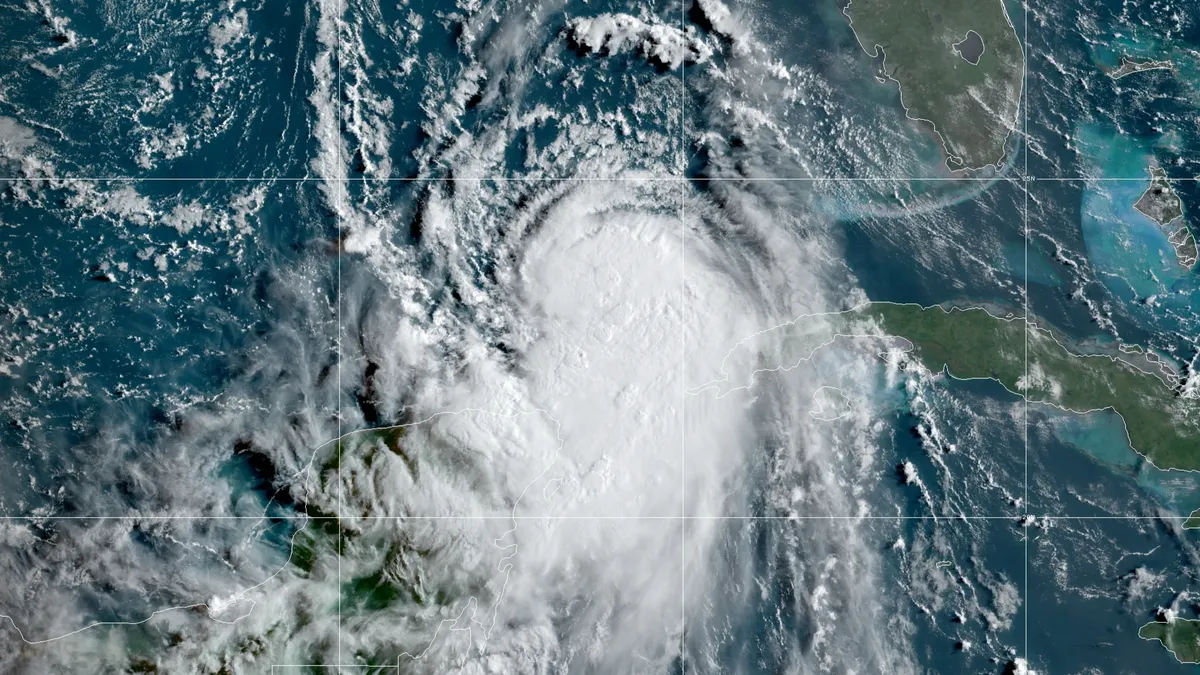Dive Brief:
- Utility crews restored power to more than 150,000 customers overnight, leaving outages caused by Hurricane Laura at 765,000 as of 8 a.m. Friday, according to the Edison Electric Institute (EEI). Louisiana bore the brunt of damage caused by the Category 4 storm that hit the Gulf Coast early Thursday morning.
- More than 20,000 utility workers from at least 28 states, Washington, D.C., and Canada have mobilized to help restore power, according to EEI. "The vast majority are supporting power restoration in Louisiana," said a spokesperson for the investor-owned utility group.
- Entergy was the most impacted utility, with more than 540,000 customers without power in Louisiana, Texas, Arkansas and Mississippi as of 4 p.m. Thursday. "Hardest hit areas may experience outages for weeks," the utility said, in part due to COVID-19 protocols that complicate the restoration process for utility crews.
Dive Insight:
For months, the electric utility sector has been preparing for this: sending tens of thousands of utility workers to restore power after a major storm — while navigating new social distancing and pandemic protocols. Experts say the new rules could have some impact on restoration, but do not anticipate significant slowdowns.
Crews from around the country are now assisting local utilities in restoring power, while implementing changes to how they work in order limit the spread of COVID-19, said Scott Aaronson, vice president of security and preparedness for EEI.
"Given the COVID-19 pandemic, crews also must follow additional safety protocols that may slow down restoration processes," EEI said in its storm update on Thursday.
"I don't think [COVID-19 is] having a big impact on time of restoration," said Aaronson. "It's a complicating factor, not a limiting one." In some instances, repair crews could actually see a boost from new deployment strategies and dispersed equipment and supply depots as part of utilities' response to coronavirus.
"There are some interesting efficiencies that are found when you have more decentralized staging areas," Aaronson said. "But there are other complicating factors, too." Utility crews are operating with one person per truck and hotel room, and there are medical screenings and tests to be coordinated, he said.
Entergy customers could see 'weeks' of outages
Of all the utilities in the region, Entergy was hit the hardest by Hurricane Laura.
Cleco Power, which has 288,000 customers throughout Louisiana, said Thursday evening on Facebook that it is "still assessing the damage to our electrical system," and that at the height of the storm Laura had caused 140,000 customers to lose power. As of 8 p.m. yesterday crews had restored power to 31,205 customers.
Southwestern Electric Power Co. said last night 94% of customers in eight central Louisiana parishes were without power after its system was damaged. In total, the utility said 128,000 customers were without power, including 79,000 in the Shreveport-Bossier area of Louisiana, 8,100 in Texas and 400 in Arkansas.
Entergy said yesterday afternoon that 262,000 customers in Louisiana were without power. Another 231,000 were offline in Texas; 5,400 in Mississippi and 42,0000 in Arkansas.
"Customers may see extended power outages. Given the intensity of this storm and the additional need for our crews to follow COVID-19 precautionary measures, hardest hit areas may experience outages for weeks," Entergy said in a statement.
The Association of Louisiana Electric Cooperatives (ALEC) said that as of 10 a.m. yesterday, more than 100,000 of its customers were in the dark.
Hurricane Laura was "the worst storm to hit southwest Louisiana with damaging winds and significant flooding," ALEC CEO Jeff Arnold said in a statement. “The recovery and rebuilding effort will take time."
Slower, but safe
Gregg Edeson, utilities expert at PA Consulting, said the new COVID protocols can slow recovery time but he does not expect a significant impact.
"They will absolutely keep their crews separate as appropriate ... and they will do their briefings in a manner that is safe and distanced, obviously masked, as appropriate," Edeson said. Restoration "might take a little longer," he said, but he added that utilities have gotten very efficient in how they restore power. Already, he said, utility workers are utilizing aerial drones to survey damaged lines and prioritize work.
The utility sector has already seen damaging storms, and so this is not the first time crews have dealt with new protocols. So far they are working, Aaronson said.
Given the utility sector has faced storm responses already this season, "we've been constantly pulsing our communities," said Aaronson, to see if there have been any outbreaks of COVID associated with recovery efforts.
"At least anecdotally, we have not seen an uptick in cases, which is a really good sign the protocols are working," he said. "It's been a busy season so far and you layer that with a pandemic on top of it, it requires a lot of good coordination."















